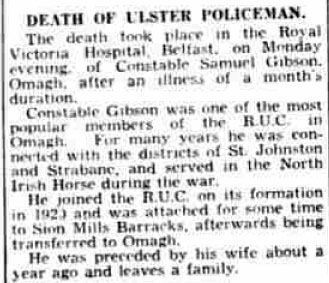Sergeant Samuel Gibson
Samuel Gibson was born on 5 June 1877 at Magherasollus, Raphoe, County Donegal, the second of eleven children of ploughman (later domestic servant) Ramsay Gibson and his wife Sophia (née Dugan). By 1900 Gibson was living at Lifford, County Donegal, where he worked as a coachman. On 31 May that year he married Alice McVicker in the Portstewart Church of Ireland Church. The couple had eight children over the next twelve years. By the time of the 1911 Census the family was living at Ballycolman, Strabane South, County Tyrone, Samuel working as a coachman.
Gibson enlisted in the North Irish Horse on 9 or 10 October 1914 (No.1299 – later Corps of Hussars No.71325). In the first half of 1915 he embarked for England with F Squadron, where they awaited orders for France. On 12 July, however, Gibson was one of about two dozen men of the squadron who volunteered for service as Military Mounted Police with the 54th (East Anglian) Division, which was under orders to join the Mediterranean Expeditionary Force. They sailed from Devonport on HMT Manitou on 29 July 1915, joining the landing at Suvla Bay between 10 and 16 August.
At the end of the year the campaign at Gallipoli was abandoned, the men of the North Irish Horse leaving in December. They arrived in Egypt the following month, where a number of them, including Gibson, remained there for the duration of the war, serving in various elements of the Egypt and Palestine campaign.
At the end of June 1918 Gibson formally transferred to the Military Mounted Police (No. P/14887) – with effect from 30 August 1917.
He was mentioned in General Allenby's despatch of 3 April 1918, which recognised "distinguished and gallant services and devotion to duty".
Gibson was transferred to Class Z, Army Reserve, on 28 February 1919.
On 7 June 1920 he joined the Royal Irish Constabulary (No.71580), serving at Roscommon until discharged at the disbandment of the force on 11 May 1922. He then joined the Royal Ulster Constabulary (No.2148), serving at Sion Mills and Omagh. He died in the Royal Victoria Hospital in Belfast on 26 September 1938, and was buried in the Omagh Cemetery.

Belfast Telegraph, 27 September 1938

Belfast Telegraph, 29 September 1938
